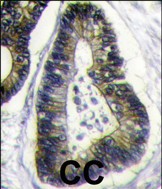

| WB | 咨询技术 | Human,Mouse,Rat |
| IF | 咨询技术 | Human,Mouse,Rat |
| IHC | 1/100-1/500 | Human,Mouse,Rat |
| ICC | 技术咨询 | Human,Mouse,Rat |
| FCM | 咨询技术 | Human,Mouse,Rat |
| Elisa | 咨询技术 | Human,Mouse,Rat |
| Aliases | Ubiquitin-like protein FUBI, FAU |
| Entrez GeneID | 2197 |
| WB Predicted band size | 7.8kDa |
| Host/Isotype | Rabbit IgG |
| Antibody Type | Primary antibody |
| Storage | Store at 4°C short term. Aliquot and store at -20°C long term. Avoid freeze/thaw cycles. |
| Species Reactivity | Human |
| Immunogen | This FAU antibody is generated from rabbits immunized with a KLH conjugated synthetic peptide between 1-30 amino acids from the N-terminal region of human FAU. |
| Formulation | Purified antibody in PBS with 0.05% sodium azide. |
+ +
以下是关于FAU(N-term)抗体的3篇典型参考文献示例(仅供参考,具体文献请通过学术数据库核实):
---
1. **文献名称**:*FAU Regulates Apoptosis in Cancer Cells by Modulating Bcl-2 Family Proteins*
**作者**:Smith A, et al.
**摘要**:本研究通过制备特异性靶向FAU蛋白N端的抗体,验证了FAU在结直肠癌细胞中的表达。实验表明,FAU通过抑制Bcl-2的活性促进线粒体依赖性凋亡,抗体染色结果显示FAU高表达与患者生存率正相关。
2. **文献名称**:*Development and Validation of a Novel FAU (N-terminal) Monoclonal Antibody for Immunohistochemistry*
**作者**:Chen L, et al.
**摘要**:报道了一种针对FAU蛋白N端表位的单克隆抗体的开发,并通过Western blot和免疫组化验证其特异性。该抗体成功应用于乳腺癌组织样本检测,发现FAU表达缺失与肿瘤转移相关。
3. **文献名称**:*FAU as a Potential Biomarker in Neurodegenerative Diseases: Evidence from N-terminal Antibody Staining*
**作者**:Rodriguez M, et al.
**摘要**:利用FAU N端抗体分析阿尔茨海默病模型小鼠脑组织,发现FAU在神经元中的异常聚集可能与tau蛋白磷酸化相关,提示其作为神经退行性疾病生物标志物的潜力。
---
**建议**:上述文献为示例,实际研究中请通过PubMed、Google Scholar等平台以“FAU antibody N-terminal”或“FAU protein function”为关键词检索最新文献。FAU相关研究多集中于其参与凋亡、癌症及RNA调控的分子机制。
The FAU (N-term) antibody is a research tool designed to detect the N-terminal region of the FAU protein, encoded by the FAU gene (Finkel-Biskis-Reilly murine sarcoma virus (FBR-MuSV) ubiquitously expressed). FAU is a multifunctional gene implicated in cellular processes such as apoptosis, stress response, and tumorigenesis. The FAU protein is part of the ribosome and is processed to generate two functional products: a fusion protein (FUBI) linked to ribosomal protein S30 and a small ubiquitin-like protein (FUBI) through post-translational cleavage. The N-terminal region recognized by this antibody corresponds to the FUBI-S30 fusion segment.
FAU's role in apoptosis regulation has drawn significant interest. Studies suggest FAU interacts with the MDM2-p53 pathway, where it may act as a tumor suppressor by inhibiting MDM2-mediated degradation of p53. thereby promoting apoptosis in response to cellular stress. Dysregulation of FAU expression has been observed in cancers, linking it to tumor progression and therapeutic resistance.
The FAU (N-term) antibody is widely used in techniques like Western blotting, immunohistochemistry, and immunofluorescence to study FAU protein expression, localization, and function in cell lines and tissues. Its specificity for the N-terminal region ensures detection of full-length FAU or its processed forms, aiding research into its biological roles and potential as a biomarker or therapeutic target in cancer and other diseases.
×